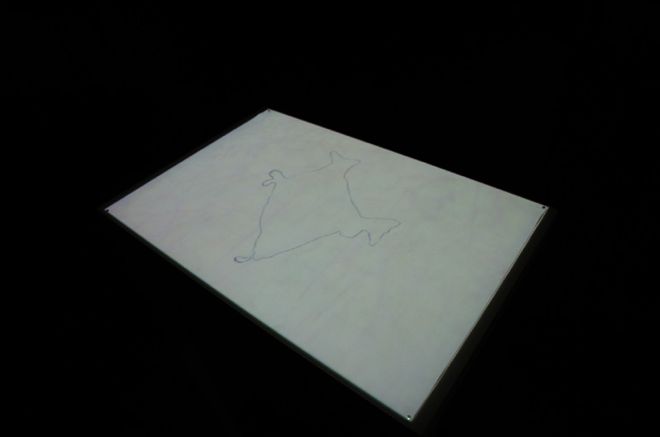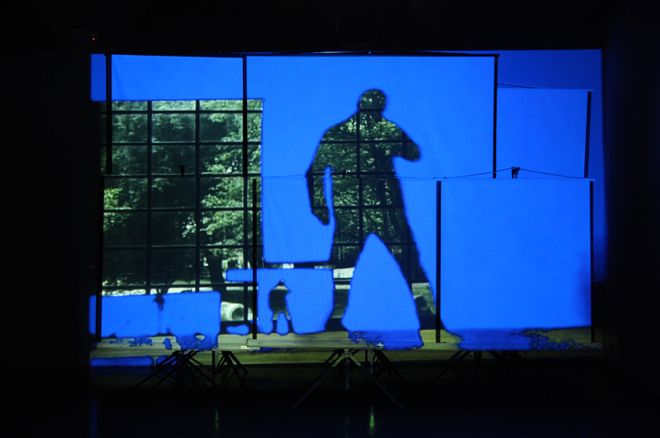LANDSEASKY: Revisiting Spatiality in Video Art
Thematic exhibition with, Paul Bai (Australia), Lauren Brincat (Australia), Jan Dibbets (The Netherlands), Barbara Campbell (Australia), Wang Gongxin (China), Shilpa Gupta (India), Yeondoo Jung (South Korea), Derek Kreckler (Australia), Giovanni Ozzola (Italy), João Vasco Paiva (Portugal/Hong Kong), Wang Peng (China), Kimsooja (South Korea), Craig Walsh (Australia), Sim Cheol Woong (South Korea), Heimo Zobernig (Austria), Yang Zhenzhong (China), Zhu Jia (China). Curated by Kim Machan.
OCAT Contemporary Art Terminal (1016 North Suzhou Road, Shanghai) April 20–June 22, 2014
(Touring to MAAP SPACE, Griffith University Art Gallery, Brisbane, September 18th – November 23rd)
“LANDSEASKY: Revisiting Spatiality in Video Art” purports to be about “spatiality”, but the choice of the works suggests that representing space is a means to a different end. A touring show initiated by Media Art Asia Pacific, LANDSEASKY presents a group of video works aligned by a deadpan approach.
Despite the works having been drawn from across the globe and the fact that they encompass a grand sweep from the history of video art, almost all show a rigorous stoicism, as if their ideal audience were other video cameras recording all that happens with neither curiosity nor retort. About half contain all the elements of the exhibition’s title, often by pointing the camera at the horizon. The period that is recorded may be quickened by formal interventions—say, a door closes off the view, as in “Garage —some times you can see much more” by Giovanni Ozzola (2009-11), or maybe the camera teeters while watching a buoy bobbing in the harbor, as in “Forced Empathy” by João Vasco Paiva (2011). In these works, not much is happening, nor is there much to look at. It is a show of single events—either a camera movement, or a formal intervention, but not both together.


One work in the exhibition reminds one of the iconic mirage sequences from David Lean’s motion picture, “Lawrence of Arabia” (1962), where Lean employed a 482 mm lens fixed on the outlying shimmer of desert sands. At first there is distance, then a wavering pixel becomes an unknown rider approaching the camera. From the haze, the fixed camera awaits the figure for a long shot. In the exhibition, Lauren Brincat deploys an equivalent cinematic strategy in “This Time Tomorrow, Tempelhof” (2011). Entering the frame at center bottom, the artist is filmed walking purposefully towards the far distance. But whereas Lean’s scenario anticipates the introduction of a live character, we see only the back of a head. The figure rapidly becomes just a dark speck. Unmoving and fixed a little above head height, the camera is an impartial witness trained on the vanishing point. In common with many other works in the show, this locked viewpoint reminds the viewer, as the figure quickly recedes, that presence endures while identity is quickly lost.

Yet video cannot be conflated with film. In film, the length of the spool limited the duration of a continuous shot; video, however, made extended recording available. When artists started using video in the 1960s, this tied in with a desire to record uninterrupted experiences while drawing attention to the perceiving presence of the artist. Unlike the high costs of TV production or the self-contained narratives of motion pictures, video technology is relatively cheap; its lowering costs allowed artists in the 60s and 70s to intervene, to create a continuous document and to investigate the repetition of images stored on magnetic tape.
Andy Warhol, for instance, seized the potential of duration in the motion picture, “Sleep” (1964), using a natural cycle to determine the start and end of the film sequence. Over six hours the film “told it like it is” in a pure mise-en-scène. However, Warhol’s film was not what it seemed; he used loops and repeated stills to direct the appearance of simply turning the camera on and leaving it running. With video came the possibility of truly fixing time passing in a disinterested gaze.
In OCAT, the generous high definition projections feel more like film than video. Some works show connections with the work of Michael Snow. In Snow’s “La Région Centrale” (1972, not in this exhibition), the camera is mounted on a pivoting device that performs a series of balletic movements. The results on screen slide from landscape to abstraction as the camera movements quicken to interfere with the capacity of the frame rate. Snow’s practice in film resonates with the aspiration to stand back and let the image occur when the camera is turned on. Snow also pursued abstraction, assessing the inherent limits of the hardware and challenging the film camera’s ability to produce a semblance of reality.


Jan Dibetts’ videos, “Horizon I – III” (1971)—exhibited—belong to this field of work. Pointing his lens away from the coast, Dibetts employs a suite of simple camera movements and tilted angles. The division of sea and sky glides across the frame suggesting geometric abstraction rather than a record of the place. In a contrary gesture, Kimsooja suggests the late abstract paintings of Mark Rothko in “Bottari —Alfa Beach” (2001). In this case, the equal division of sea and sky is turned upside down. The inverted image records the beach in Nigeria notorious as the place where new capture slaves began their journey away from Africa. The unflinching camera fixes the ineffable geometry of the two elements on a 378 second loop, releasing time to contemplate the presence of the void and the absence of humanity.
Distance, signaled by the horizon that appears in several works, reminds us that we are in a gallery and that the landscape is a projection we cannot physically enter. Derek Kreckler reinforces this point in his “Untitled” (2013), a brooding ocean with a high horizon. In a theatrical gesture, the screen is cut into strips and occasionally sent flying chaotically by an oscillating fan, only to fall back into place to await another wave. The real wind produced by the fan reiterates the projection’s artifice while enhancing its elemental subject. As the wind causes the screen to fly apart, the space behind is revealed.


Another kind of horizon is found in Shilpa Gupta’s affecting work “100 Hand Drawn Maps of India” (2007), a series of people’s best guesses at the shape of India, cross-fading in quick succession on a flat screen. At first, this might appear to produce a more humane work. The participants in Gupta’s project record a place between their metaphorical homeland and the actual territory they draw. Rather than suggesting the aspiration and personal belief that is nationhood, the work rehearses a model that could be replayed endlessly. Arguably, the potency of these hand-drawn borders has already been exhausted through circulation⎯not only in interminable frontier disputes, but also through the signification of maps in art as metaphors of ownership and classification, from Johannes Vermeer to Chinese agitators Ai Weiwei and Xu Zhen.


In most of the exhibition, digital video is used both to document and to generate live situations. In Yeondoo Jung’s twin channel “Handmade Memories— On the Dividing Line Between Body and Soul” (2008), however, the truth of what is witnessed is questioned. It shows a first person account of an encounter on a train journey juxtaposed with the illusion of a gently-drifting movement down railway lines. The ride proceeds from the false reality of a theatrical set to a projection, itself receding on dolly rails into the back of the stage. In the narrative, the speaker claims that experiences on the journey helped him understand a book, “On the Dividing Line Between Body and Soul”. The relationship between the fictions played out across the two screens appears unfathomable. Despite being shown the mechanics of the effect, the spatial illusion of proceeding down the railway tracks is believable—convincing, at least, from the perspective of the camera. It is the only work to specify the unreliability of what is seen in front of the camera.
Again linked with the idea of truth, Wang Peng’s “Feeling North Korea” (2012) includes recordings from a hidden camera made on a trip to Pyongyang, but half of the screen is black. Suggesting the half-truth of a covert state, the blank part of the screen also evokes the pre-state of formatted recording media: a void zone of potential. In this blackness lies the capacity of the hardware to probe. It suggests that video is not a neutral mechanism, but one predisposed to curiosity and always ready to report (and replay).
Horizontal dark bands remove parts of the image in an interactive display, Campbell’s “close, close” (2014), which shows footage of birds in stages of a migratory journey. . The advance and retreat of the viewer affects what is seen and what is covered. t. Unlike other works, the projection thus requires a spectator; yet here, in this blacked-out space, witnessing the birds’ innate will to migrate, one realizes that for many of these projections, humanity is simply redundant, and that human life itself is merely a momentary incident in the endless capacity of video to record.


On a different note, Wang Gongxin’s “The Other Rule in Ping Pong” (2014) brings a little humor to the exhibition. The three parts of the work interact with a haphazard time signature. One screen shows a mouth spitting a ping-pong ball into space. A second screen, orientated horizontally, records the balls ricocheting on a table tennis table. The third screen documents absurd attempts to return the ball with inappropriate equipment. Wang plays effortlessly with the audience interface. The angled arrangement of the screens does not apply the logical symmetry necessary for the game to be played. Although the work produces a 3D sensation between the video images, it is an unpredictable ball to dodge in the spectator’s space. This is the most nuanced work in the exhibition in terms of its disclosure of the possibilities of using video to discuss space; Wang’s work brings athleticism to the theme.. The work makes it particularly clear that elsewhere it is the effect of automatic production that is important. From an activist perspective land, sea and sky are always in the making.
In sum, if “LANDSEASKY” is an exhibition about space, it is about how space is experienced in places being modified by a video environment; space receding from place, its content and coherence becoming more and more disconnected from perception. These videos are documents without empathy or responsibility; with vanishing points, but without the implied human presence of constructed perspective.
Jorge Luis Borges in “The Analytical Language of John Wilkins” makes fiction out of an encyclopedia, the “Celestial Empire of Benevolent Knowledge”. The category of animals is divided into fourteen types, the final class being, ‘that which from a long way off look like flies’. Borges identifies the vulnerability that the distance bestows, the need to look again and to seek the character of the subject. Representing space in “LANDSEASKY” demonstrates that an objective view is rarely a truly neutral view. For the artist, space signifies a responsibility to memorialize, as well as to represent.








